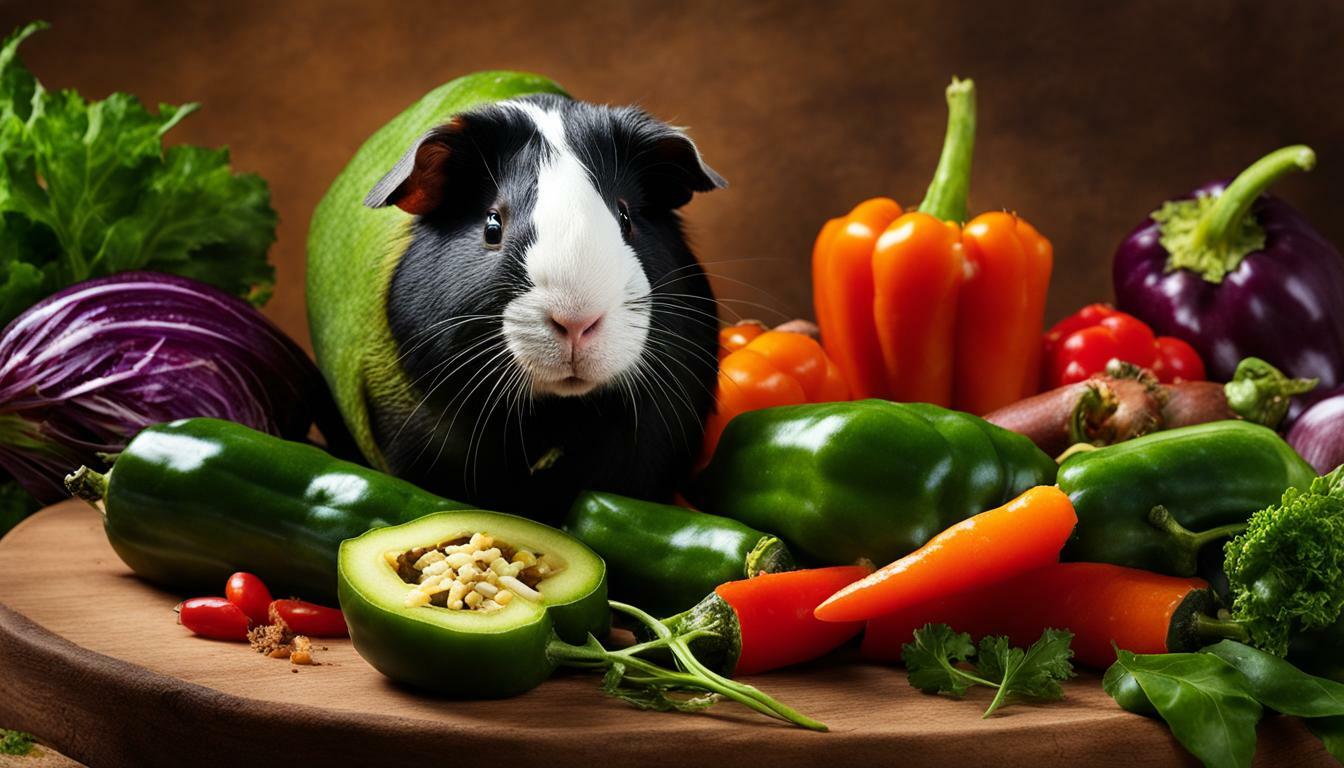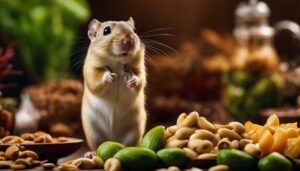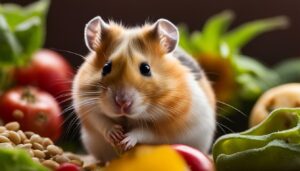If you’re wondering whether guinea pigs can eat poblano peppers, you’ve come to the right place. Guinea pigs are herbivores and their diet primarily consists of hay, fresh vegetables, and fruits. While some vegetables are safe for guinea pigs to consume, it’s important to determine if poblano peppers are suitable for their digestive system.
Key Takeaways:
- Guinea pigs can eat bell peppers, including poblano peppers
- Poblano peppers are rich in vitamins, minerals, and antioxidants
- Remove seeds, stems, and leaves before feeding bell peppers to guinea pigs
- Wash bell peppers thoroughly to remove any pesticides or dirt
- Limit the amount of sweet peppers due to their higher sugar content
The Benefits of Including Poblano Peppers in Your Guinea Pig’s Diet
Poblano peppers can offer a range of health benefits for your furry friend when incorporated into their diet. These peppers are packed with essential nutrients that can support your guinea pig’s overall well-being.
First and foremost, poblano peppers are a safe vegetable for guinea pigs to consume. They contain high levels of vitamin C, which is crucial for preventing scurvy in guinea pigs. This vitamin also supports their immune system and aids in the absorption of iron from other foods. By including poblano peppers in their diet, you can ensure that your guinea pig receives an adequate amount of vitamin C.
In addition to vitamin C, poblano peppers are rich in other vitamins and minerals, such as vitamin A, vitamin K, and potassium. These nutrients contribute to healthy blood and blood vessels, promote proper digestion, and help maintain strong bones and teeth. They also provide antioxidants that can protect your guinea pig’s cells from damage caused by free radicals.
When feeding poblano peppers to your guinea pig, it’s important to follow a few precautions. Remove the seeds, stems, and leaves of the peppers, as these parts can be toxic or cause choking. Thoroughly wash the peppers to remove any pesticides or chemicals that may be present. It’s also recommended to introduce the peppers gradually and monitor your guinea pig for any adverse reactions.
| Health Benefits of Poblano Peppers |
|---|
| High in vitamin C, which prevents scurvy and supports the immune system |
| Rich in vitamins A and K, and potassium for overall health |
| Provide antioxidants for cell protection |
| Support healthy blood and blood vessels |
| Aid in digestion and promote strong bones and teeth |
Remember, while poblano peppers can be a healthy addition to your guinea pig’s diet, they should be given in moderation. Too many peppers, especially those with higher sugar content, can lead to digestive issues. It’s always best to consult with a veterinarian to determine the appropriate serving size and frequency of poblano peppers for your individual guinea pig.
By incorporating poblano peppers into your guinea pig’s diet, you can provide them with a variety of nutrients that contribute to their overall health and well-being. Just remember to follow the necessary precautions and feed these peppers in moderation.
Nutritional Value of Poblano Peppers for Guinea Pigs
Poblano peppers are packed with essential vitamins and minerals that can contribute to your guinea pig’s overall health. These peppers are a great source of vitamin C, which is vital for the immune system and helps prevent scurvy in guinea pigs. The vitamin C content in poblano peppers is higher than in many other vegetables, making it a valuable addition to your pet’s diet.
In addition to vitamin C, poblano peppers also provide your guinea pig with vitamin A, which is essential for maintaining healthy eyesight and promoting good skin health. These peppers are also rich in vitamin B6, which aids in the metabolism of proteins and supports overall body functions.
Poblano peppers are low in calories and fat, making them a healthy option for your guinea pig. They also contain important minerals such as potassium, which helps maintain proper hydration, and manganese, which supports bone health and metabolism.
| Nutrient | Amount per 100g of Poblano Peppers |
|---|---|
| Vitamin C | 74mg |
| Vitamin A | 1050IU |
| Vitamin B6 | 0.36mg |
| Potassium | 261mg |
| Manganese | 0.16mg |
Remember to introduce new foods gradually into your guinea pig’s diet and monitor their reaction. It’s important to provide a varied and balanced diet to ensure your guinea pig receives all the essential nutrients they need for optimal health. While poblano peppers can be a nutritious addition, they should be given in moderation alongside a mix of other fresh vegetables recommended for guinea pigs.
Incorporating Poblano Peppers into Your Guinea Pig’s Diet
- Wash the poblano pepper thoroughly to remove any pesticides or dirt.
- Remove the stem, seeds, and white membrane, as they can be difficult for guinea pigs to digest and potentially cause digestive issues.
- Cut the pepper into small, bite-sized pieces to make it easier for your guinea pig to eat.
- Introduce poblano peppers gradually, starting with small portions to observe your guinea pig’s reaction.
- Offer a variety of other safe vegetables alongside poblano peppers to ensure a balanced diet.
By incorporating poblano peppers into your guinea pig’s diet in a responsible manner, you can provide them with additional nutrients and variety while ensuring their overall well-being.
Proper Preparations for Feeding Poblano Peppers to Your Guinea Pig
While poblano peppers are safe for guinea pigs, it’s important to follow certain guidelines and prepare them properly. Here are some essential preparations to ensure your guinea pig can safely enjoy poblano peppers:
- Remove the seeds and stems: Poblano peppers, like other bell peppers, have seeds and stems that can be harmful to guinea pigs. These parts can cause choking or digestive issues. Make sure to remove the seeds and stems before serving poblano peppers to your furry friend.
- Thoroughly wash the peppers: Poblano peppers, just like any other vegetables, should be washed thoroughly to remove any pesticides or dirt. Wash them under running water and gently rub the surface to ensure they are clean before feeding them to your guinea pig.
- Introduce gradually: When introducing any new food to your guinea pig’s diet, including poblano peppers, it’s important to do so gradually. Start by offering a small amount and observe their response. If there are no signs of digestive upset, you can continue to include poblano peppers in their diet in moderation.
By following these preparations, you can ensure that your guinea pig can safely enjoy the nutritional benefits of poblano peppers. However, it’s always a good idea to consult with a veterinarian before making any significant changes to your guinea pig’s diet.
Table: Safe and Unsafe Vegetables for Guinea Pigs
| Safe Vegetables | Unsafe Vegetables |
|---|---|
| Bell peppers | Onions |
| Cucumbers | Garlic |
| Zucchini | Potatoes |
| Romaine lettuce | Tomatoes |
| Carrots | Chives |
Remember to always offer a variety of safe vegetables to your guinea pig to ensure a well-rounded and nutritious diet. Monitor their response to new foods and consult with a veterinarian if you have any concerns about their diet or health.
Potential Risks and Precautions When Feeding Poblano Peppers to Guinea Pigs
While poblano peppers can be a healthy addition to your guinea pig’s diet, there are a few risks and precautions to keep in mind. Although poblano peppers are generally safe for guinea pigs to consume, they can sometimes cause digestive issues, especially if fed in excessive amounts or if your guinea pig has a sensitive stomach.
One important precaution to take when feeding poblano peppers to your guinea pig is to ensure that they are thoroughly washed to remove any pesticides or dirt. Pesticides can be harmful to your furry friend, so it’s essential to clean the peppers properly before offering them as a treat.
Additionally, make sure to remove the seeds, stems, and any parts of the pepper that may be hard or difficult to chew. These parts can pose a choking hazard to your guinea pig and should be avoided. You can cut the pepper into small, bite-sized pieces to make it easier for your guinea pig to eat and digest.
Table: Risks and Precautions When Feeding Poblano Peppers to Guinea Pigs
| Risks | Precautions |
|---|---|
| Digestive issues | Feed in moderation and observe your guinea pig’s reaction |
| Pesticide exposure | Thoroughly wash the peppers to remove any pesticides |
| Choking hazard | Remove seeds, stems, and hard parts. Cut into small, bite-sized pieces |
It’s also important to introduce poblano peppers gradually into your guinea pig’s diet. Start by offering a small amount and monitor their reaction. If your guinea pig shows any signs of discomfort or digestive issues, it’s best to discontinue feeding them poblano peppers.
As with any new food, it’s always wise to consult with a veterinarian before introducing it into your guinea pig’s diet. They can provide specific guidance based on your guinea pig’s individual needs and health condition.
How to Safely Include Poblano Peppers in Your Guinea Pig’s Diet
By following these tips, you can safely introduce and incorporate poblano peppers into your guinea pig’s meals. Poblano peppers are a nutritious addition to your pet’s diet, providing essential vitamins and minerals. However, it’s important to remember that moderation is key and to always prioritize your guinea pig’s well-being.
When offering poblano peppers to your guinea pig, start by introducing small pieces and gradually increase the amount over time. This allows their digestive system to adjust and prevents any potential digestive upset. Additionally, make sure to remove the seeds, stems, and leaves before feeding the pepper to your guinea pig. These parts can be difficult to digest and may cause discomfort or choking hazards.
Before serving poblano peppers, it’s crucial to wash them thoroughly to remove any pesticides or chemicals that may be present on the skin. Organic peppers are generally considered a safer option, as they are grown without the use of harmful chemicals. Remember to always choose fresh and ripe peppers, as overripe or spoiled peppers can negatively impact your guinea pig’s health.
Table: Safe Vegetables for Guinea Pigs
| Vegetables | Serving Size | Frequency |
|---|---|---|
| Poblano Peppers | Small pieces | 2-3 times per week |
| Bell Peppers (red, yellow, orange) | Small pieces | 2-3 times per week |
| Romaine Lettuce | 1-2 large leaves | Every day |
| Cucumber | Thin slices | 2-3 times per week |
Remember that while poblano peppers are safe for your guinea pig to consume, they should be offered as part of a balanced and varied diet. It’s important to include a variety of vegetables to provide your pet with different nutrients. Always monitor your guinea pig’s response to new foods and consult with a veterinarian if you have any concerns or questions regarding their diet.
Recommended Serving Size and Frequency of Poblano Peppers for Guinea Pigs
While poblano peppers can be a healthy addition to your guinea pig’s diet, it’s important to feed them in moderation. The recommended serving size of poblano peppers for guinea pigs is about one to two slices, depending on the size of your pet. It’s essential to remember that guinea pigs have small digestive systems, so too much of any food can lead to digestive issues.
As for the frequency of feeding poblano peppers to your guinea pig, it’s best to offer them as an occasional treat rather than a regular part of their daily meals. Two to three times a week is a suitable frequency to ensure that your guinea pig receives the nutritional benefits without overloading their system.
When introducing poblano peppers to your guinea pig’s diet, start with a small amount and observe their reaction. Some guinea pigs may have sensitive stomachs or allergies to certain foods, so it’s important to monitor them for any adverse reactions. If you notice any digestive upset or unusual behavior, discontinue feeding poblano peppers and consult with a veterinarian.
Table: Recommended Serving Size and Frequency
| Serving Size | Frequency |
|---|---|
| 1-2 slices | 2-3 times a week |
In summary, poblano peppers can be a nutritious addition to your guinea pig’s diet. However, it’s crucial to feed them in moderation and pay attention to your guinea pig’s individual dietary needs and reactions. Always consult with a veterinarian for personalized guidance on your guinea pig’s diet and health.
Other Suitable Vegetables for Guinea Pigs
Poblano peppers are not the only vegetable option for your guinea pig, and there are several other safe and nutritious vegetables to consider. These vegetables provide essential vitamins and minerals that contribute to your guinea pig’s overall health and well-being. It’s important to introduce a variety of vegetables into your guinea pig’s diet to ensure they receive a balanced and nutritious meal.
One popular vegetable choice for guinea pigs is leafy greens. These include options like spinach, romaine lettuce, and kale. Leafy greens are rich in vitamins A and C, which are essential for guinea pigs’ immune system and overall health. They also provide fiber, which aids in digestion and promotes a healthy gut.
Another vegetable option to consider is bell peppers. Along with poblano peppers, bell peppers come in various colors and provide a range of nutrients. Bell peppers are low in calories and high in vitamin C, making them an excellent addition to your guinea pig’s diet. Just like with poblano peppers, remember to remove the seeds and wash them thoroughly before feeding them to your guinea pig.
Here are some other safe and nutritious vegetables suitable for guinea pigs:
| Vegetable | Nutritional Benefits |
|---|---|
| Carrots | Rich in vitamin A, which is essential for eye health and immune function. |
| Cucumber | High in water content, providing hydration, and a source of vitamin K. |
| Zucchini | Low in calories and high in vitamins A and C, plus a good source of fiber. |
Remember, when introducing new vegetables to your guinea pig’s diet, do so gradually and in small quantities. This allows their digestive system to adjust and helps prevent any potential digestive issues. Always wash vegetables thoroughly to remove any pesticides or dirt that might be present. Providing a varied selection of vegetables will ensure that your guinea pig receives a diverse range of nutrients for optimal health and happiness.
Creating a Balanced and Nutritious Diet for Your Guinea Pig
Incorporating a variety of vegetables, including poblano peppers, is key to providing a balanced and nutritious diet for your guinea pig. These small pets have specific dietary requirements that need to be met to ensure their overall health and wellbeing. Including a range of vegetables in their diet not only provides essential nutrients but also adds variety and enrichment to their meals.
When it comes to guinea pig nutrition, it’s important to understand which vegetables are safe and suitable for them to consume. Poblano peppers, along with other bell pepper varieties, can be an excellent addition to their diet. Bell peppers are low in calories and packed with essential vitamins, minerals, and antioxidants that can support your guinea pig’s overall health.
Guinea pigs can benefit from the nutrients found in bell peppers, such as vitamin C, which is crucial for their immune system and preventing scurvy. These vegetables also contain vitamin A, which promotes healthy vision, and vitamin K, which supports blood clotting and proper bone health. Additionally, bell peppers provide dietary fiber, which aids in digestion and keeps their digestive system healthy.
| Benefits of Incorporating Poblano Peppers into Your Guinea Pig’s Diet | Recommended Serving Size | Frequency |
|---|---|---|
| Rich in essential vitamins and minerals | 1-2 small slices per serving | 2-3 times per week |
| Contains antioxidants | ||
| Promotes healthy digestion | ||
| Supports immune system |
When introducing poblano peppers to your guinea pig’s diet, it’s important to do so gradually. Start with small slices and monitor their response. If your guinea pig shows any signs of digestive upset, such as diarrhea or reduced appetite, discontinue feeding them poblano peppers and consult your veterinarian.
Remember, while poblano peppers can be a healthy addition to your guinea pig’s diet, they should be offered in moderation. Variety is key, so ensure you’re also providing other safe vegetables for your furry friend. Wash all vegetables thoroughly to remove any pesticides or dirt, and remove any seeds, stems, or leaves that may be toxic or cause choking hazards.
Other Suitable Vegetables for Your Guinea Pig’s Diet
In addition to poblano peppers, there are several other vegetables that you can include in your guinea pig’s diet. Some of the safe options include:
- Romaine lettuce
- Cucumber
- Zucchini
- Carrots
- Celery
These vegetables provide a range of nutrients and flavors to keep your guinea pig’s diet interesting and well-rounded. Remember to introduce new vegetables gradually and monitor your guinea pig’s response to ensure they tolerate them well.
By incorporating a variety of vegetables, including poblano peppers, into your guinea pig’s diet, you can provide them with a balanced and nutritious meal. Remember to consult with your veterinarian if you have any concerns or questions about your guinea pig’s specific dietary needs.
Conclusion
After considering the nutritional benefits, precautions, and recommendations, it is safe to say that guinea pigs can enjoy poblano peppers as part of a balanced diet. Poblano peppers are a type of bell pepper that is safe for guinea pigs to consume. Bell peppers, including poblano peppers, are rich in vitamins, minerals, and antioxidants, making them a healthy addition to their diet.
The nutrients in poblano peppers can contribute to improved digestion, support healthy blood and blood vessels, provide antioxidants, prevent scurvy, promote eye health, and offer other health benefits for your guinea pig. However, it is important to note that guinea pigs should not eat the whole pepper. They should avoid the seeds, stems, and leaves of bell peppers as these can be toxic or cause choking.
To safely incorporate poblano peppers into your guinea pig’s diet, it is recommended to feed them in moderation, removing the seeds and washing them thoroughly. It is also advisable to vary the colors of bell peppers your guinea pig consumes, limiting the amount of sweet peppers due to their higher sugar content. This will ensure a well-rounded and nutritious diet for your furry friend.
Remember, although poblano peppers are safe for guinea pigs to eat, it is always important to introduce new foods gradually and monitor your guinea pig’s reaction. If you have any concerns or questions about your guinea pig’s diet, it is best to consult with a veterinarian who can provide personalized advice based on your pet’s specific needs.
FAQ
Can guinea pigs eat poblano peppers?
Yes, guinea pigs can eat poblano peppers as part of their diet.
Are bell peppers safe for guinea pigs?
Yes, bell peppers are safe for guinea pigs to eat, including poblano peppers.
What are the benefits of feeding poblano peppers to guinea pigs?
Poblano peppers are rich in vitamins, minerals, and antioxidants that can improve digestion, contribute to healthy blood and blood vessels, provide antioxidants, prevent scurvy, promote eye health, and offer other health benefits.
Can guinea pigs eat the whole pepper?
No, guinea pigs should avoid eating the seeds, stems, and leaves of bell peppers as they can be toxic or cause choking.
How should I prepare poblano peppers for my guinea pig?
It is important to remove the seeds and wash the peppers thoroughly before feeding them to your guinea pig.
Can guinea pigs eat different colored bell peppers?
Yes, guinea pigs can enjoy bell peppers of different colors, but it is recommended to limit the amount of sweet peppers due to their higher sugar content.
How much poblano pepper should I feed my guinea pig?
It is important to feed poblano peppers to your guinea pig in moderation and as part of a balanced diet.
What are other suitable vegetables for guinea pigs?
There are many other safe and suitable vegetables for guinea pigs, such as carrots, cucumbers, and leafy greens.
How can I create a balanced and nutritious diet for my guinea pig?
To create a balanced and nutritious diet for your guinea pig, you should incorporate a variety of vegetables, hay, pellets, and fresh water.
Can guinea pigs eat poblano peppers every day?
It is recommended to offer a variety of vegetables to your guinea pig and not feed poblano peppers every day.




